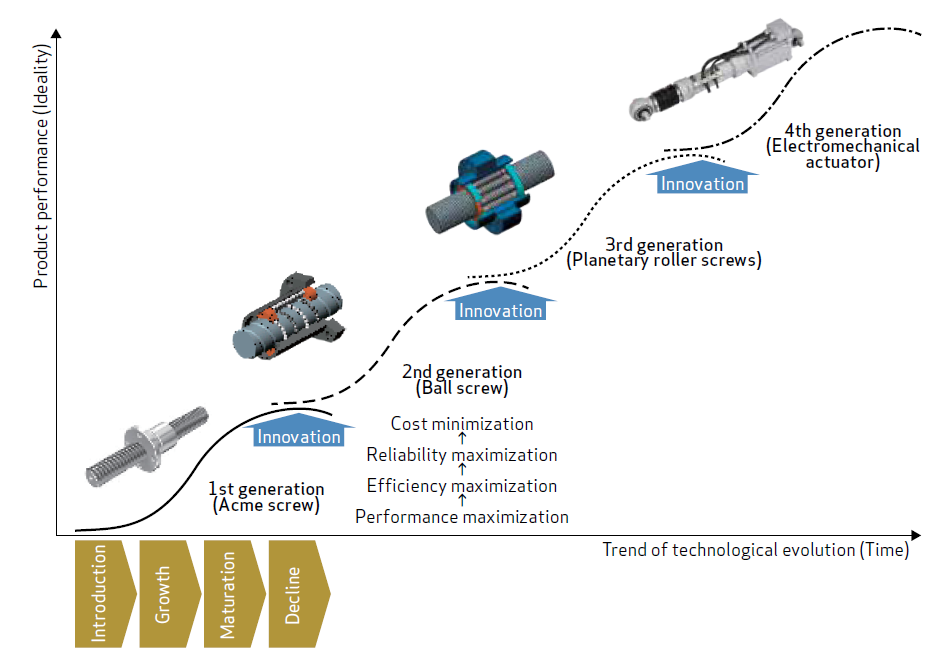MENU
TOPIC THREE
EVOLUTION OF BALL SCREW AND PLANETARY ROLLER SCREW TECHNOLOGY
S-curve Analysis of Screw Technology
If you plot the "benefits" of an evolving system as a function of time, you generally obtain a well-defined S-curve (Figure 8). This curve is a representation of a system in two dimensions, where the horizontal axis represents technological evolution of the system (time) and the vertical axis represents system performance (ideality).
In an analysis using S-curves, one curve appears after another, indicating product evolution. The shape of each S-curve is somewhat reminiscent of the Product Lifecycle: a marketing concept whereby the lifecycle of a product is divided into four phases: Introduction, Growth, Maturation, and Decline. Combining S-curve analysis with the Product Lifecycle is one means of identifying ideas for product innovation.
S-curves allow you to grasp which stage the technology under development is in and how it will progress in the future. This information can also provide hints for further innovation and invention. For example, when screw technology is construed in the context of mono-, bi-, and poly-systems of different objects represented by the TRIZ evolutionary trends (Note 2) as shown in Figure 8, the process of evolution is represented as Acme (pointed) screw > Ball screw > Planetary roller screw > Electromechanical actuator.The objectives of researchers and engineers change depending on the present position on the S-curve. In the Introduction Phase (of the Product Lifecycle), the focus is on the introduction of the product or technology without fussing over details. In the Growth Phase, the focus shifts to performance optimization. In the Maturation Phase, the aim is to optimize efficiency and reliability. And in the Decline Phase, cost minimization becomes the most important issue.
Note 2:
TRIZ is a problem solving methodology based on the analysis of 2.5 million patents. The founders Altshuller et al. found regular patterns in the evolution of technologies. TRIZ is a tool which classifies technological evolution into 14 patterns.
- Introduction of new objects
- Introduction of improved objects,
- Evolution of similar objects into mono-, bi-, and poly-structures,
- Evolution of different objects into mono-, bi-, and poly-structures, etc.
Electromechanical actuators, which may be seen as the fourth generation of screw technology (refer to Figure 8), are in the Introductory Phase when viewed as an actuator. In other words, they have considerable potential for development in aspects such as performance and efficiency. Miniaturization is one example. Inverse planetary roller screws, where rollers are positioned on the shaft side, can be designed shorter than standard roller screws with the rollers positioned on the nut. Inverse planetary roller screws will become almost half the size of conventional planetary roller screws. There may also be integration of the nut and actuator which would lower system cost through a reduction in the number of parts.

Figure 8: S-curve analysis of screw technology
Latest Trends of Ball Screw and Planetary Roller Screw Technologies
Detailed characteristics and user requirements for ball screws and planetary roller screws will be described in the next article (i.e. Part 2). Prior to that, here is an overview of some of the latest trends in ball screw and planetary roller screw technology.
For example, in the fields of semiconductors, medical equipment, measuring instruments, and liquid crystal devices, increased application of ball screws will require further miniaturization, higher speeds, and greater cleanliness. On the other hand, improvements in load capacity, vibration/noise, service life, heat resistance, and other characteristics are necessary for the further application of ball screws to machine tools.
Small ball screws with a shaft diameter of 2.0 mm or less and a screw lead of approximately 0.5 mm are already in practical use. Triple thread screws with three leads are also a reality, enabling high-speed feeding at low rotation speed without greatly increasing the speed of the drive motor. Attention is also being paid to screw material, surface treatment, lubricants, and other factors, in order to reduce contamination. Furthermore, long life, large-diameter ball screws have been developed for high-load machine tools.
As for trends in planetary roller screws, many applications for planetary roller screws are shared with ball screws. Planetary roller screws are best suited to industrial machines, testing machines, special machines, etc. Low vibration/low noise, high load capacity, high responsiveness (high speed and acceleration), high rigidity, long service life, heat resistance, customizability, and other characteristics are important in such applications.
The application of a planetary roller screw to the hydraulic cylinder of an injection molding machine is a noteworthy example. Strict pressure control is required for such a hydraulic cylinder in order to assure mold accuracy. Consequently, a hydraulic pump, pipes, seals, and a control unit are required, resulting in a large size. However, by employing a planetary roller screw, you could configure a closed-loop, all-electric mechanism and with all the control benefits of electromechanical technology, while still being cost competitive.